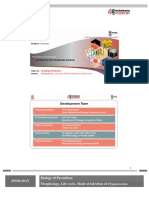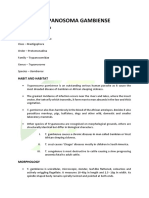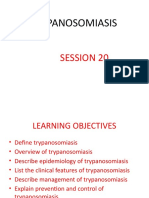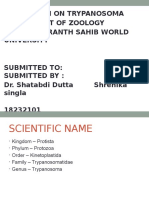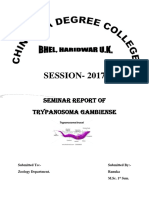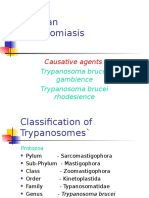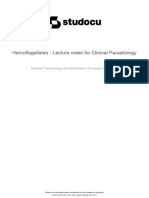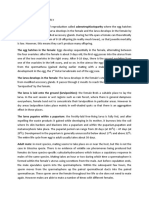STUDENT NAMES:
Parasitology Case Study
NURS230 – Microbiology for Nursing
Prepared by: Dr. Nour Fattouh
Spring 2025
Trypanosoma brucei gambiense and Trypanosoma brucei rhodesiense are parasites that cause the
sleeping sickness also known as African trypanosomiasis. This disease is endemic to sub-Saharan
Africa being the natural habitat of Tsetse flies. The life cycle of these parasites is shown in the figure
below.
1|P a g e
�A. Explain the life cycle of this parasite.
The 3-week life cycle in the tsetse fly begins with ingestion of trypomastigotes in a blood meal from
the reservoir host. They multiply in the insect gut and then migrate to the salivary glands, where
they transform into epimastigotes, multiply further, and then form metacyclic trypomastigotes,
which are transmitted by the tsetse fly bite. The organisms in the saliva are injected into the skin,
where they enter the bloodstream, differentiate into blood-form trypomastigotes, and multiply,
thereby completing the cycle.
B. Identify the definitive, intermediate, and reservoir hosts. Explain your answers.
This parasite only reproduces asexually via binary fission thus, we can’t identify an intermediate and
a definitive host. The reservoir host is the human being which the insect vector is going to take the
parasite from.
C. Identify the infective stage of this parasite. Explain your answer.
The infective stage of the parasite is the metacyclic trypomastigote (stage 1 in the life cycle) since it
will be transmitted to humans by the bite of a tsetse fly.
D. What do you think are the signs and symptoms of this parasitic infection?
Although both species cause sleeping sickness, the progress of the disease differs. A Trypanosoma
brucei gambiense infection is chronic while a Trypanosoma brucei rhodesiense infection is acute and
usually leads to death within several months. In both cases, the initial lesion is a skin ulcer known
as a trypanosomal chancre that is found at the site of the fly bite. After the organisms enter the
blood, intermittent weekly fever and lymphadenopathy develop. The encephalitis is characterized
initially by headache, insomnia, and mood changes, followed by muscle tremors and eventually
somnolence and coma.
2|P a g e
























